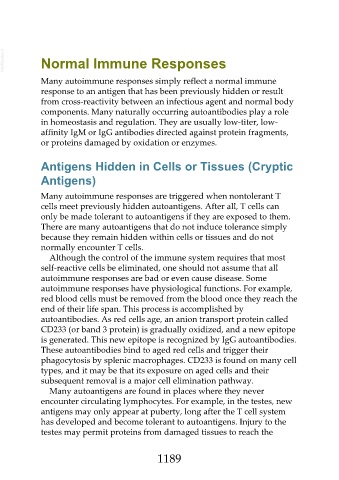Page 1189 - Veterinary Immunology, 10th Edition
P. 1189
VetBooks.ir Normal Immune Responses
Many autoimmune responses simply reflect a normal immune
response to an antigen that has been previously hidden or result
from cross-reactivity between an infectious agent and normal body
components. Many naturally occurring autoantibodies play a role
in homeostasis and regulation. They are usually low-titer, low-
affinity IgM or IgG antibodies directed against protein fragments,
or proteins damaged by oxidation or enzymes.
Antigens Hidden in Cells or Tissues (Cryptic
Antigens)
Many autoimmune responses are triggered when nontolerant T
cells meet previously hidden autoantigens. After all, T cells can
only be made tolerant to autoantigens if they are exposed to them.
There are many autoantigens that do not induce tolerance simply
because they remain hidden within cells or tissues and do not
normally encounter T cells.
Although the control of the immune system requires that most
self-reactive cells be eliminated, one should not assume that all
autoimmune responses are bad or even cause disease. Some
autoimmune responses have physiological functions. For example,
red blood cells must be removed from the blood once they reach the
end of their life span. This process is accomplished by
autoantibodies. As red cells age, an anion transport protein called
CD233 (or band 3 protein) is gradually oxidized, and a new epitope
is generated. This new epitope is recognized by IgG autoantibodies.
These autoantibodies bind to aged red cells and trigger their
phagocytosis by splenic macrophages. CD233 is found on many cell
types, and it may be that its exposure on aged cells and their
subsequent removal is a major cell elimination pathway.
Many autoantigens are found in places where they never
encounter circulating lymphocytes. For example, in the testes, new
antigens may only appear at puberty, long after the T cell system
has developed and become tolerant to autoantigens. Injury to the
testes may permit proteins from damaged tissues to reach the
1189

